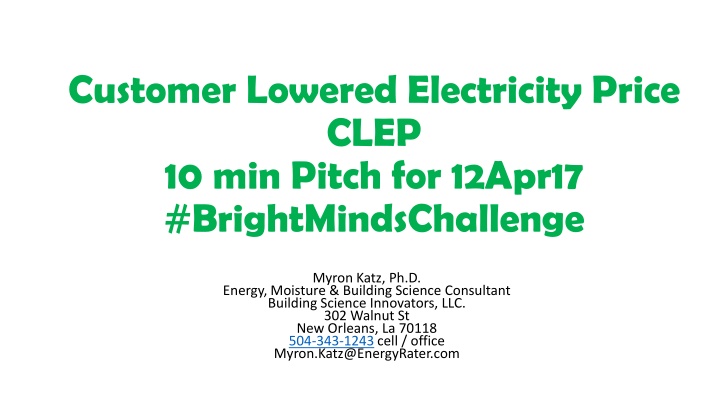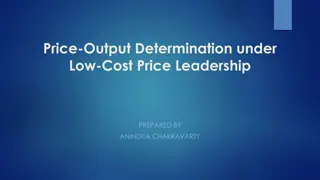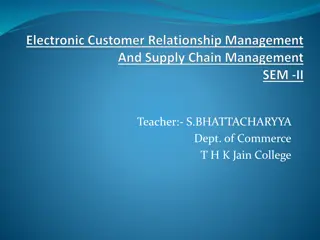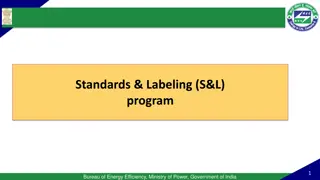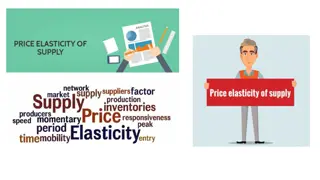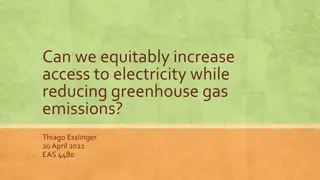Customer Lowered Electricity Price - CLEP Definitions & Savings
Customer Lowered Electricity Price program focuses on reducing electricity costs for all customers through innovative strategies. This includes adjusting demand charges, incentivizing peak-hour consumption, and promoting energy-efficient technologies like solar power and battery storage. By implementing CLEP, customers can save significantly on annual electricity expenses while reducing carbon emissions. Explore the various cost-saving opportunities and environmental benefits associated with the CLEP program.
Download Presentation

Please find below an Image/Link to download the presentation.
The content on the website is provided AS IS for your information and personal use only. It may not be sold, licensed, or shared on other websites without obtaining consent from the author.If you encounter any issues during the download, it is possible that the publisher has removed the file from their server.
You are allowed to download the files provided on this website for personal or commercial use, subject to the condition that they are used lawfully. All files are the property of their respective owners.
The content on the website is provided AS IS for your information and personal use only. It may not be sold, licensed, or shared on other websites without obtaining consent from the author.
E N D
Presentation Transcript
Customer Lowered Electricity Price CLEP 10 min Pitch for 12Apr17 #BrightMindsChallenge Myron Katz, Ph.D. Energy, Moisture & Building Science Consultant Building Science Innovators, LLC. 302 Walnut St New Orleans, La 70118 504-343-1243 cell / office Myron.Katz@EnergyRater.com
Definitions of Customer Lowered Electricity Price, (CLEP) Notes: A. The $50 factor in CLEPm s definitions may be adjusted to optimally encourage CLEP acceptance but not undermine: CLEP transactions lower the electricity price for all customers. B. The negative demand charge paid to a residential customer viewed in $/KW-y should not exceed 2x the highest demand charge paid by a non-residential, non-CLEP customer in $/KW- y. C. If a customer does not have air-conditioner- dominated demand, then replace $50 with $50/2. D. Utility peak hours are annual and occur within May through Sept, weekdays, and are between 2 p.m. and 7 p.m.; otherwise CLEPm = $0 for that month. E. CLEPm generates a payment whenever average demand during peak hours is negative. F. Avoided demand is observed by real-time comparison to performance of homes of similar age. G. p and q are extra controls to allow the utility regulator to ensure that goals are met. For a residential ratepayer who voluntarily accepts the CLEP tariff, A Monthly CLEP Payment = CLEPm+ CLEP5 where: CLEP5 = p * n * (e - w) is calculated every 5 min p = Utility-regulator determined, percent and 0 < p < 2; n = Number of kWh purchased by the customer. If the flow is outbound (i.e., a sale), n is negative; w = Wholesale cost of power e = Monthly average cost of energy (fuel cost adjustment) Buy Low Sell High where: CLEPm = q * $50 * d is calculated monthly d = Average demand during utility peak hours avoided (i.e., d= observed reference building demand minus observed demand) q = Utility-regulator determined percent and 0 < q < 2. Negative Demand Charge For a non-residential ratepayer who voluntarily accepts the CLEP tariff, CLEP is the same as defined for residential ratepayers except, CLEPm is redefined and replaces all demand charges CLEPm = q * $50 * d is calculated monthly d = Average demand during utility peak hours Whendis positive, CLEPm creates a high demand charge paid by the customer. When used to finance Community Solar, CLEP is the same as defined for non-residential ratepayers except, CLEP5 is replaced with p * n * w
Probable First Costs and Annual Savings of CLEP for a Customer using Entergy New Orleans Electricity CLEP VS no CLEP Additional1 or Alternative2 Annual Savings with CLEP Annual Savings without CLEP First Cost [1 $ lbs of CO2 CLEP5 CLEPm lbs of CO2 $ / $ 130 / 0 Dishwasher 1301 $0 $0 0 $6 $20 520 / 250 Water Heater $201 $2501 5701 $1000 $250 2500 985 / 900 Community Solar $3602 $6252 01 $5,000 $900 10800 1000 / 0 Whole Home Battery 24001 $10,000 -$10 0 $100 $900 Rooftop Solar with Battery 1800 / 900 $2502 $15502 01 $27,500 $900 10800
CLEP Battery Pilot Cashflow Over 10 years 2 3 4 600 300 300 600 600 600 First & last years are 6 months long 9 10 Year 1 5 6 7 8 11 SUMS Sold Units Total # of Units Sold Mid-Year Convention Cumulative # Units Sold 600 600 600 600 600 600 600 # Sold under Direct Control DOLLARS Sales Retail Revenue Wholesale Costs of sold units Sales Tax 200 400 400 400 400 400 400 400 400 400 200 $10,920,000 $8,400,000 $840,000 $10,920,000 $8,400,000 $840,000 Bill Credit for Control by Utility Power Supply benefit from control Leased Units Total # Units Leased Mid-Year Convention DOLLARS Undepreciated Leased Assets Lease Revenue Power Supply benefit from control Depreciation Return on Rate Base Marketing Other O&M $285,000 $570,000 $570,000 $570,000 $570,000 $570,000 $570,000 $570,000 $570,000 $570,000 $285,000 $5,700,000 $300,000 $600,000 $600,000 $600,000 $600,000 $600,000 $600,000 $600,000 $600,000 $600,000 $300,000 $6,000,000 400 200 400 400 400 400 400 400 400 400 400 400 400 400 400 400 400 400 400 400 400 200 $3,080,000 $105,600 5,852,000 $211,200 5,236,000 4,620,000 4,004,000 3,388,000 2,772,000 $211,200 $211,200 $211,200 2,156,000 $211,200 1,540,000 $211,200 $924,000 $211,200 $308,000 $105,600 $0 $211,200 $211,200 $2,112,000 $300,000 $308,000 $338,800 $5,000 $100,000 $600,000 $616,000 $643,720 $600,000 $616,000 $575,960 $600,000 $616,000 $508,200 $600,000 $616,000 $440,440 $600,000 $616,000 $372,680 $600,000 $616,000 $304,920 $600,000 $616,000 $237,160 $600,000 $616,000 $169,400 $600,000 $300,000 $616,000 $169,400 $6,000,000 $6,160,000 $3,726,800 $308,000 $33,880 $10,000 $10,000 $10,000 $10,000 $10,000 $10,000 $10,000 $10,000 $10,000 $10,000 $200,000 Contribution to Cost of Service $1,348,800 $428,520 $360,760 $293,000 $225,240 $157,480 $89,720 $21,960 $45,800 $113,560 $68,720 $200
Utility Regulators View of CLEP Compared to Alternative Strategies Helps Finance Rooftop Solar Balances Supply vs Demand Promotes Energy Efficiency Finances Community Solar Timely Charge or Reward Fully Pays for Whole Home Batteries Low Administrative Cost Real Performance Based Market Transformations Reduces CO2 Production Lowers Electricity Prices Treats Peak's Shoulders Low Regulatory Burden Reduces Consumption Requires Smart Meters Continuously Effective Pays as well as Retail Adequately Granular Cheap to Implement Looks Like a Subsidy Quick to Implement Improves Reliability Adjusts to Changes Shifts Time of Use Reduces Demand Goals vs Strategies Shaves Peaks Market Based Not a Subsidy Simple Tax Fixed Price Rates Demand Charges Inclining Block Rates Time of Use Rates Load Management Demand Response Demand-Side Management Consumer Education x x x x x x x x x x x x x x x x x x x x x x x x x x x x x x x x x x x x x x x x x x x x x x x x x x x x x x Critical Peak Pricing Peak Time Rebate Real-Time Pricing Net Energy Metering Value of Solar X x x x x x x x x x x x x x x x x x x x x x x x x x x x x x x x x x x x x x x x x x Integrated Resource Planning x x x Carbon Tax x x x x CLEP x x x x x x x x x x x x x x x x x x x x x x x x x x x
CLEP Endorsements Neil Abramson, J.D.; Ways & Means Chairman, Louisiana House of Representatives James Gray, J.D.; New Orleans City Councilman; Utility Committee member; very interested in CLEP Pres Kabakoff, Pres., HRI Properties; national real estate developer; civic leader; philanthropist Marcel Wisznia, AIA; Past Pres AIA of LA., Wisznia Associates; developer; business-civic leader Tommy Milliner, J.D.; utility watchdog advocate for over two decades; Energy Law Fellow, Tulane Univ. Daniel Weiner, AIA; LEED AP; past president The Green Project; a founder of Tulane Green Club Z Smith, PhD, AIA;solar technology innovator; past president USGBC, Louisiana New Orleans National Energy Industry Professionals Michael Holtz, FAIA; President, Light Louver; past President, Architectural Energy Corp. (developer of REM/Rate); past Chief, Bldg Systems Research and Acting Director, Solar Energy Research Institute (now NREL); founding board member, RESNET Richard Faesy, Prin., Energy Futures Group; Energy Efficiency Mgr., Vermont Energy Investment Corp; founding board member, RESNET; RESNET Lifetime Achievement Awardee Ken Fonorow, founding president National Energy Raters Association; board member RESNET, RESNET Market Transformation Leadership awardee, consultant for 1st Zero Energy Home, SE U.S. Gary Nelson, Owner, Energy Conservatory; innovator of building performance testing and diagnostics instruments Gary Klein, Gary Klein & Associates; Staff of California Energy Commission; water and sustainability consultant & RESNET leader Dennis Stroer,current board member RESNET; past president, National Energy Raters Association Gabrielle Stebbins, past Executive Director, Renewable Energy Vermont Ned Ford, National Global Warming and Energy Committee, Sierra Club; Energy Efficiency analyst, activist and advocate in Ohio
